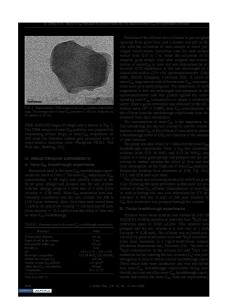Photoemission Study of Single Crystal C 60
- PDF / 465,832 Bytes
- 6 Pages / 420.48 x 639 pts Page_size
- 3 Downloads / 334 Views
PHOTOEMISSION STUDY OF SINGLE CRYSTAL C60
J.WU, Z.-X. SHEN, D. S. DESSAU, R. CAO, D. S. MARSHALL, P. PIANETFA, I. LINDAU, AND X. YANG, J. TERRY, D. M. KING, B. 0. WELLS Stanford Synchrotron Radiation Laboratory and Stanford Electronics Laboratories, Stanford, CA 94309 ABSTRACT We report angle-resolved photoemission data from single crystals of C60 cleaved in UHV. Unlike the other forms of pure carbon, the valence band spectrum of C60 consists of many sharp features that can be essentially accounted for by the quantum chemical calculations describing individual molecules. This suggests that the electronic structure of solid C6 0 is mainly determined by the bonding interactions within the individual molecules. We also observe remarkable intensity modulations of the photoemission features as a function of photon energy, suggesting strong final state effects. Finally, we address the issue of the band width of the HOMO state of C60. We assert that the width of the photoemission peak of C60 does not reflect the intrinsic band width.
INTRODUCTION C60, a newly discovered form of pure carbon, is a molecule with 60 carbon atoms that occupy the 60 vertices formed by the intersections of 20 hexagonal and 12 pentagonal faces to form a hollow cage. Unlike graphite and diamond, solid C 60 is a molecular crystal. The C-C bonds within an individual C 60 molecule (1.4 A and 1.46 A) are significantly shorter than the smallest C-C nearest neighbor distance between the molecules, which is about 3 A. This leads us to a model of the solid C 6 0 that is comprised of well-separated C 60 molecules, with each molecule consisting of 60 tightly bonded carbon atoms. In this paper, we present results of our experimental studies of C6 0 single crystals. We focus on two primary issues: (i) electronic structure mainly determined by the bonding interactions within individual molecules and (ii) the band width induced by electron hopping between the C6 0 molecules. We show that the valence band spectrum of C 60 exhibits many sharp features, and can be very well accounted for by the electronic states of the individual molecule with small modifications due to the band effects in the solid. This is in contrast to the spectra of graphite and diamond, which show broad features due to large energy dispersion. Furthermore, we observe very strong intensity modulations of the photoemission features as a function of photon energy. This intensity modulation is indicative of final state effects. The experimental results of the band width obtained by different techniques are presently controversial. Band widths of about 80-200 meV [1-5] were obtained indirectly from the density of states measured in IR reflectivity, NMR, critical field, and magnetic susceptibility experiments. Contradicting these results, the peak widths for both the highest valence band state and the lowest conduction band state range from 800 meV to 1200 meV in the existing photoemission spectra from polycrystalline samples [6-10]. We performed the first angleresolved photoemission experiments
Data Loading...











